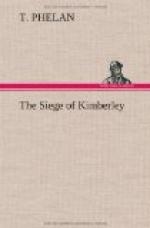From an artist’s point of view a town with high stone buildings would have offered better raw material for picturesque ruins. In Kimberley we had but one substantial building that would meet the necessities of the case, viz., the City Hall. It was the only imposing structure we could boast of, and was by consequence the harder to hit, albeit some creditable tries were made to hit it. Large holes were dug in the Market Square, in which process of grave-digging by storm a little girl was injured—not by a shell, but by the volley of small pebbles it displaced. This class of buckshot—apart from the missiles themselves—did a good deal of light skirmishing about the calves of people’s legs, and threw dust in their eyes with the force and fury of a “south-easter.” One gentleman, meandering in the Square, narrowly evaded dismemberment, and was fortunate in getting off with a slight bruise. Another hissing monster went tearing through the roof of the Buffalo Club, upsetting a billiard table, and laying it out a disordered heap of firewood on the floor. Fire-wood was worth something; and since chips of his anatomy were not in the heap—perchance to be utilised in the cooking of horseflesh for somebody else to eat—its grateful proprietor conducted himself with resignation.
Meanwhile the scattered fragments of the same mischievous projectile careered gaily through the air. One piece—no bigger than a Siege loaf—with sardonic humour embedded itself in the stomach of a horse and killed it instantaneously. This was pitiful, for the animal had been fed, and was in the very act of being shod. The smith escaped unhurt. Another missile tested the metal of a boiler, in a house in Belgravia, by smashing it into scrap-iron. Whether the shell was intended for a batch of bread in the adjoining oven is uncertain; the satisfactory fact remained that the bread was unbroken. Buildings which had been but imperfectly ventilated by the smaller shells had proper port-holes made in them, and chimney-tops went down like nine-pins. We were, in short, in a couple of hours afforded a grim conception of what modern munitions can do. To that extent the assault was instructive. But that extent was small and did not impress our common sense—which, by the way, was small, too, and not at all common.
At six o’clock the firing ceased, and the “Mafeking terror” was allowed to cool. I might as well explain here that our surmise was entirely wrong. The gun came from—nobody knew where; but everybody said, from Mafeking. We said more; the Cape Government (the Bond Ministry) had purchased it in England for the Transvaal, in furtherance, as was implied, of the projected sweeping of the English into the sea. This was a hugged delusion until some fool dispelled it by discovering the gun to be a “creuzot” which had been purchased in France by the Transvaal. But it mattered little where it had been purchased; it was a tangible




